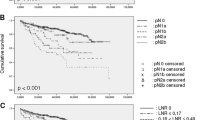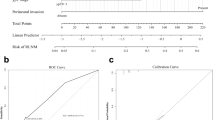Abstract
PURPOSE: An aggressive surgical approach with en bloc resection of involved structures is often possible with anterior rectal cancers that invade adjacent visceral organs, but is rarely possible in tumors that invade the pelvic wall. However, most staging systems include both situations in the same group of T4 rectal cancers. We performed a retrospective study of patients with stage T4 rectal cancer undergoing surgery to assess the influence of different organ involvement on resectability and survival. METHODS: A retrospective review was conducted of 84 patients with T4 rectal cancer treated at the University of Minnesota and affiliated hospitals over a ten-year period. Forty-seven patients (56 percent) were staged for local invasion on the basis of final pathology, 19 (23 percent) on the basis of operative findings, and 18 (21 percent) on the basis of ultrasound images. Patients were divided into two groups, those with or without pelvic wall involvement. Resectability, local control, and overall survival were compared between groups. Survival curves were estimated by the Kaplan-Meier method and compared by log-rank test. Multivariate analysis was performed with Cox proportional and logistic regression. RESULTS: Thirty-one patients (37 percent) had involvement of the pelvic wall, whereas 53 patients (63 percent) had visceral involvement only. All 29 patients with distant metastasis died of their disease. Forty-seven of the 55 patients without distant metastasis underwent tumor resection. Age and pelvic wall involvement were the only two factors independently associated with the probability of resection in logistic regression analysis (P=0.0067 andP=0.037, respectively). The only factor that affected median survival in patients without distant metastasis was tumor resection (49.1 months for resectionvs. 6.1 months for no resection,P=0.017). Patients with visceral involvement had a longer median survival (49.2 months) than those with pelvic wall involvement (13.2 months), but the difference did not reach statistical significance (P=0.058). CONCLUSION: Rectal cancers with pelvic and visceral involvement have different rates of resectability and median survival. These differences should be reflected in the TNM classification system.
Similar content being viewed by others
References
Fleming ID, Cooper JS, Henson DE,et al. AJCC cancer staging handbook. Philadelphia: Lippincott-Raven, 1998;10.
Ries LA, Eisner MP, Kosary CL,et al, eds. SEER cancer statistics review 1973–1997. DHHS Publ. No. 00-2789. 2000.
Orkin BA, Dozois RR, Beart RW Jr, Patterson DE, Gunderson LL, Ilstrup DM. Extended resection for locally advanced primary adenocarcinoma of the rectum. Dis Colon Rectum 1989;32:286–92.
MacFarlane JK, Ryall RD, Heald RJ. Mesorectal excision for rectal cancer. Lancet 1993;341:457–60.
Adam IJ, Mohamdee MO, Martin IG,et al. Role of circumferential margin involvement in the local recurrence of rectal cancer. Lancet 1994;344:707–11.
Hall NR, Finan PJ, Al-Jaberi T,et al. Circumferential margin involvement after mesorectal excision of rectal cancer with curative intent: predictor of survival but not local recurrence? Dis Colon Rectum 1998;41:979–83.
Lindsey I, Guy RJ, Warren BF, Mortensen NJ. Anatomy of Denonvilliers' fascia and pelvic nerves, impotence, and implications for the colorectal surgeon. Br J Surg 2000;87:1288–99.
Chen ET, Mohiuddin M, Brodovsky H, Fishbein G, Marks G. Downstaging of advanced rectal cancer following combined preoperative chemotherapy and high dose radiation. Int J Radiat Oncol Biol Phys 1994;30:169–75.
Minsky BD, Cohen AM, Enker WE,et al. Preoperative 5-FU, low-dose leucovorin, and radiation therapy for locally advanced and unresectable rectal cancer. Int J Radiat Oncol Biol Phys 1997;37:289–95.
Chan A, Wong A, Langevin J, Khoo R. Preoperative concurrent 5-fluorouracil infusion, mitomycin C and pelvic radiation therapy in tethered and fixed rectal carcinoma. Int J Radiat Oncol Biol Phys 1993;25:791–9.
Shumate CR, Rich TA, Skibber JM, Ajani JA, Ota DM. Preoperative chemotherapy and radiation therapy for locally advanced primary and recurrent rectal carcinoma: a report of surgical morbidity. Cancer 1993;71:3690–6.
Videtic GM, Fisher BJ, Perera FE,et al. Preoperative radiation with concurrent 5-fluorouracil continuous infusion for locally advanced unresectable rectal cancer. Int J Radiat Oncol Biol Phys 1998;42:319–24.
Marsh RD, Chu NM, Vauthey JN,et al. Preoperative treatment of patients with locally advanced unresectable rectal adenocarcinoma utilizing continuous chronobiologically shaped 5-fluorouracil infusion and radiation therapy. Cancer 1996;78:217–25.
Mohiuddin M, Regine WF, Marks G. Prognostic significance of tumor fixation of rectal carcinoma: implications for adjunctive radiation therapy. Cancer 1996;78:717–22.
Landry JC, Koretz MJ, Wood WC,et al. Preoperative irradiation and fluorouracil chemotherapy for locally advanced rectosigmoid carcinoma: phase I–II study. Radiology 1993;188:423–6.
Meterissian SH, Skibber JM, Giacco GG, el-Naggar AK, Hess KR, Rich TA. Pelvic exenteration for locally advanced rectal carcinoma: factors predicting improved survival. Surgery 1997;121:479–87.
Gunderson LL, Nelson H, Martenson JA,et al. Locally advanced primary colorectal cancer: intraoperative electron and external beam irradiation +/- 5-FU. Int J Radiat Oncol Biol Phys 1997;37:601–14.
Harrison LB, Minsky BD, Enker WE,et al. High dose rate intraoperative radiation therapy (HDR-IORT) as part of the management strategy for locally advanced primary and recurrent rectal cancer. Int J Radiat Oncol Biol Phys 1998;42:325–30.
Author information
Authors and Affiliations
About this article
Cite this article
Yiu, R., Wong, S.K., Cromwell, J. et al. Pelvic wall involvement denotes a poor prognosis in T4 rectal cancer. Dis Colon Rectum 44, 1676–1681 (2001). https://doi.org/10.1007/BF02234389
Issue Date:
DOI: https://doi.org/10.1007/BF02234389




